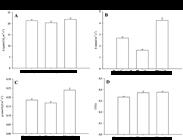ABSTRACT
Sorghum arundinaceum (Desv.) Stapf is a weed that belongs to the Poaceae family and is widespread throughout Brazil. Despite the frequent occurrence, infesting cultivated areas, there is little research concerning the biology and physiology of this species. The objective of this research was to evaluate the growth, carbon partitioning and physiological characteristics of the weed Sorghum arundinaceum in greenhouse. Plants were collected at regular intervals of seven days, from 22 to 113 days after transplanting (DAT). In each sample, we determined plant height, root volume, leaf area and dry matter, and subsequently we perfomed the growth analysis, we have determined the dry matter partitioning among organs, the accumulation of dry matter, the specific leaf area, the relative growth rate and leaf weight ratio. At 36, 78 and 113 DAT, the photosynthetic and transpiration rates, stomatal conductance, CO2 concentration and chlorophyll fluorescence were evaluated. The Sorghum arundinaceum reached 1.91 in height, with slow initial growth and allocated much of the biomass in the roots. The photosynthetic rate and the maximum quantum yield of FSII are similar throughout the growth cycle. At maturity the Sorghum arundinaceum presents higher values of transpiration rate, stomatal conductance and non-photochemical quenching coefficient (NPQ).
Key words:
growth analysis, gas exchange; chlorophyll a fluorescence

 Thumbnail
Thumbnail
 Thumbnail
Thumbnail
 Thumbnail
Thumbnail
 Thumbnail
Thumbnail
 Thumbnail
Thumbnail
 Thumbnail
Thumbnail





